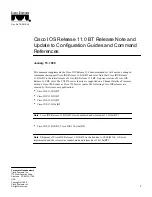
1-4
IP Service Manager User Guide
Infrastructure and Services Management Provision Overview
•
Your Network Devices
The following sections describe these components and how they interact in more detail.
Your Network Devices
The network managed by ISM Provision consists of your current existing network of
Extreme Network devices, or a subset of your devices. Many devices can be managed
by ISM Provision simultaneously. The devices are managed by querying them for their
configurations, and by sending new configuration commands to them. Once ISM
Provision manages a device, it will periodically check that the device configuration for
changes.
ISM Provision Server
The ISM Provision server is the heart of ISM Provision. You may have more than one
instance of the other components, but only one server. The server contains the
information about the configurations of the managed devices, configurations that are
scheduled to be applied to the network at a later time, and previous configurations. An
ISM Provision server can contain the configurations of a large number of devices, but
does not communicate with the devices directly. Instead, it uses device communicators
to handle this task.
The ISM Provision server also contains the saved configuration changes that have not
yet been applied to the network. These changes may be saved to edit later, or may be
applied at a future time to the network.
Device Communicators
The device communicators control the communication between the network devices
and the ISM Provision server. All queries to devices from the ISM Provision server and
all commands from the ISM Provision server to the devices are handled by the device
communicators. To spread the processing load across hosts, there can be more than one
device communicator in an ISM Provision installation, but only one per host.
For example, in a network of 100 devices all managed with the same ISM Provision
server, you might have five different device communicators, each talking with twenty
devices. Any one managed device can only be managed by one device communicator,
otherwise conflicts will occur.















































